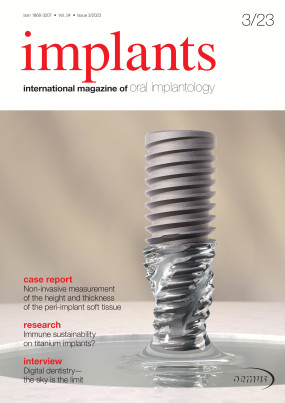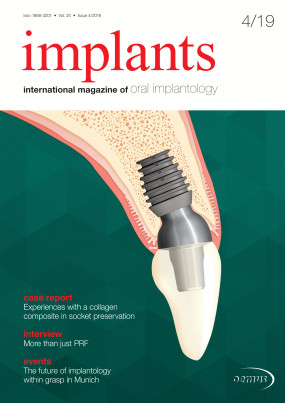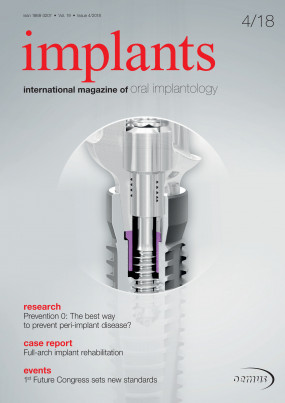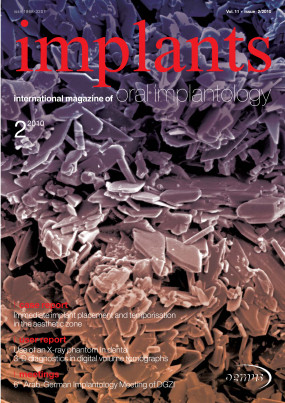Inhaltsverzeichnis
3
Editorial: A great congress in Hamburg
Dr Georg Bach, President of the German Association of Dental Implantology
Dear colleagues and friends, We are looking back on a fantastic DGZI annual congress! Once again, the venerable Hanseatic city of Hamburg proved to be a good venue for the DGZI—a significantly increased number of participants, a consistently excellent atmosphere that ran like a golden thread through the two content-packed days and an extremely interesting programme—all of which is very pleasing! The oldest European implantology society will have very fond memories of Hamburg and would like to thank everyone in- volved—it really has been a pleasure...
4
6
Immediate placement and loading of ceramic implants in the aesthetic region: One-year follow-up—two case reports
Drs Alexandre Marques Paes da Silva, Dennis de Carvalho Ferreira, Thamires Alves Silva, Mayla Kezy Silva Teixeira, Daniel de Moraes Telles & Eduardo José Veras Lourenço, Brazil
In the late 1990s, yttria-stabilised zirconia (Y-TZP) emerged as a versatile and promising material with wide applicability in implant dentistry. Among the advantages of this material, its white colour and opacity stand out, these properties allowing it to mimic the appearance of natural teeth. Owing to its mechanical properties, mainly the ability to withstand high masticatory loads, zirconia has been used not only for creating restorations but also for the manufacture of ceramic implants.1...
16
Extreme maxillary bone reconstruction with CERASORB Bioactive—a case report
Drs Fernando Duarte & Carina Ramos, Portugal
Ossifying fibroma is classified as, and behaves like, a benign bone neoplasm. It is often considered to be a type of fibroosseous lesion. This bone tumour consists of highly cellular, fibrous tissue that contains varying amounts of calcified tissue resembling bone, cementum or both.1 Owing to the presence of both bone and cementum-like tissue in ossifying fibromas, these lesions are described using the terms “ossifying fibroma”, “cementoossifying fibroma” and “cementifying fibroma”.2 Nonetheless, the consensus is that these three terms describe the same underlying type of lesion.3,4
20
A fully guided digital workflow for predictable implant planning and placement
Dr Beat R. Kurt, Switzerland
A 62-year-old male patient was referred to my practice for implant planning and treatment in the maxillary anterior region. The teeth in the maxillary anterior region had all undergone endodontic therapy, and teeth #11-22 had received crowns owing to an accident that had occurred 30 years before. The patient reported pain and was conscious that tooth #21 was mobile (Figs. 1a & b)...
24
Biocompatibility of CAD/CAM biomaterials for bone tissue engineering application
Dr Katharina Pippich, Katharina Hast, Adem Aksu, Stefanie Grom, Dr Tobias Wolfram, Frank Reinauer, Dr Dr Andreas Fichter, Dr Dr Achim von Bomhard, Germany
Large bone defects have so far mainly been treated with autogenous bone grafts. Owing to limited availability and donor site morbidity, research is ongoing into the development of various bone replacement materials. An advantage of CAD/CAM implants is the possibility of patientspecific engineering. Ceramics and polymers have been extensively investigated, but not all materials can be produced in a standardised and patient-specific way yet. In this study, a wide range of materials were investigated, all of which can be CAD/CAM manufactured and individually dimensioned in the clean room with standardised techniques using digital light processing, selective laser sintering and fused deposition modelling...
34
In the ever-evolving landscape of modern dentistry, technology continues to reshape the way professionals approach their craft. Among the many groundbreaking innovations in recent years, the Penguin II implant stability quotient (ISQ) device from Integration Diagnostics Sweden stands as a shining example of progress. This remarkable device is redefining implant dentistry and en- hancing patient outcomes like never before...
36
“Implantology is teamwork—no ifs and buts!”—this was the opening statement by Dr Georg Bach, President of the German Association of Dental Implantology (DGZI), at the 52nd International Annual Congress, which took place in Hamburg on 6 and 7 October. What was true at the beginning of oral implantology in the late 1960s/early 1970s is just as valid today—if not more so. Reason enough for the DGZI, as the oldest European specialist society, to place this year’s congress under the motto “Team”: while the first day of the congress focused on 25 table clinics and two surgical tutorials, Saturday was entirely dedicated to science: 50 renowned speakers delivered out- standing scientific presentations to over 350 participants. The annual congress was completed by the oral hygiene day and seminars for practice teams as well as by a large adjoining dental exhibition featuring a three-dozen selected, “handpicked” industry partners...
40
The ITI World Symposium is back and better than ever: more than 50 world renowned speakers will present at the world’s largest scientific implant dentistry event in Singapore from 9–11 May 2024. Building on its previous highly successful online edition, the ITI World Symposium 2024 once again puts patients at the centre of the action. Over three days, the more than 4,000 participants will experience real patients and their stories on stage. The speakers will discuss various treatment options based on the latest scientific evidence. But it does not stop there: world class clinicians will provide commentary on exclusively recorded clinical procedures live on stage...














































































